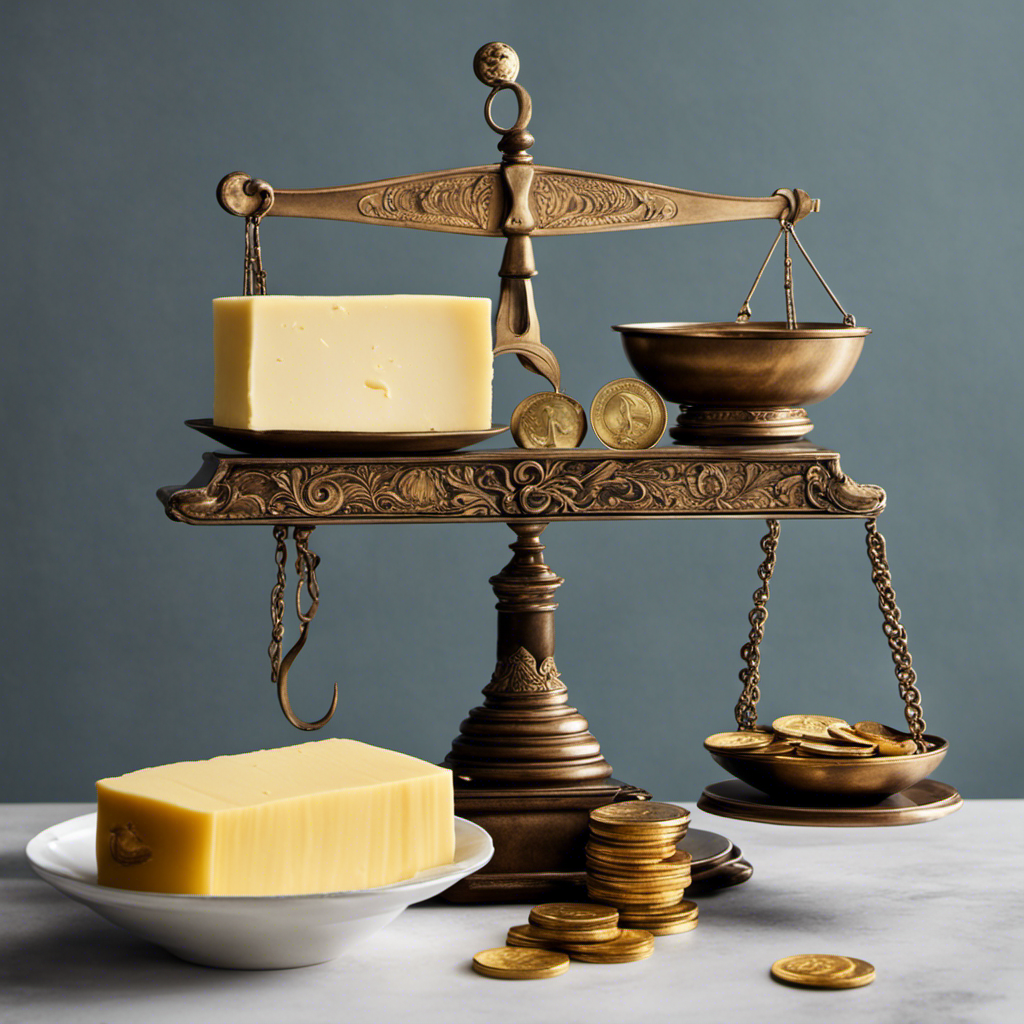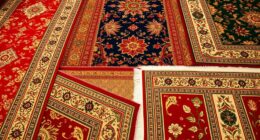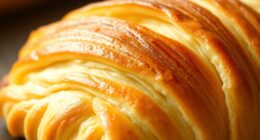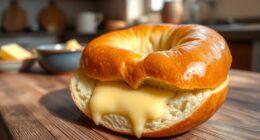As a person who delights in self-care rituals, body butter strikes me as a sumptuous indulgence for my skin. It feels like receiving a warm, comforting embrace that makes me feel cherished and well-nourished.
In this article, I’ll share my knowledge and expertise on how to use body butter effectively. From choosing the right one for your skin type to applying it with the perfect massage techniques, I’ll guide you through every step.
Get ready to experience the ultimate luxury for your skin.
Key Takeaways
- Consider your skin type and choose a body butter that is compatible with it
- Look for body butters that contain hydrating ingredients like shea butter, cocoa butter, and coconut oil
- Perform a patch test before applying to check for potential allergens
- Warm up a small amount of body butter between your palms and massage onto dry areas
Choosing the Right Body Butter for Your Skin Type
When choosing the right body butter for your skin type, it’s important to consider its moisturizing properties and compatibility with your specific needs. Body butters are rich in hydrating ingredients like shea butter, cocoa butter, and coconut oil, which help to nourish and moisturize the skin.
It’s crucial to find a body butter that suits your fragrance preferences as well. Some people enjoy scented body butters, while others prefer unscented options. When selecting a fragrance, it’s essential to ensure that it is suitable for your skin and won’t cause any potential allergic reactions. Always check the ingredients list and perform a patch test before applying the body butter all over your body.
Considering these factors will help you find the perfect body butter that keeps your skin moisturized and smelling great without any adverse reactions.
Preparing Your Skin for Body Butter Application
When it comes to achieving smooth and radiant skin, exfoliating is a key step that should not be overlooked. By gently removing dead skin cells, exfoliating helps to improve the texture and appearance of the skin, making it the perfect canvas for body butter application.
Additionally, hydrating the skin before applying body butter can enhance its effectiveness, as well as provide long-lasting moisture and nourishment.
Exfoliating for Smoothness
To achieve smoother skin, you’ll want to exfoliate before applying the body butter. Exfoliating offers numerous benefits for your skin. It helps to remove dead skin cells, unclog pores, and improve blood circulation, resulting in a healthier and more radiant complexion.
There are different exfoliating techniques you can try, such as using a scrub or a brush. Scrubs contain granules that gently slough off dead skin cells, while brushes help to stimulate blood flow and promote cell turnover. When exfoliating, remember to be gentle and avoid overdoing it, as this can cause irritation.
After exfoliating, your skin is ready to absorb the nourishing properties of the body butter. So, let’s move on to the next step, which is hydrating your skin before application.
Hydrating Before Application
Before applying the body butter, make sure you hydrate your skin to maximize its absorption. Hydrating your skin before using body butter has several benefits. Firstly, it helps to prevent greasy residue that can often be left behind when applying body butter directly onto dry skin. By moisturizing beforehand, your skin becomes more receptive to the body butter, allowing it to penetrate deeper and provide better results. Secondly, pre-moisturizing helps to create a barrier on your skin, locking in moisture and preventing dryness. This is particularly beneficial for those with dry or sensitive skin. Lastly, hydrating your skin before applying body butter can enhance the overall effectiveness of the product, leaving your skin feeling soft, smooth, and nourished. Now, let’s move on to how to apply body butter to dry skin.
| Benefits of Pre-Moisturizing |
|---|
| Prevents greasy residue |
| Creates a moisture barrier |
| Enhances the product’s effectiveness |
Transitioning into the subsequent section about ‘how to apply body butter to dry skin’, it is important to follow the right steps to ensure maximum benefits.
How to Apply Body Butter to Dry Skin
Once you’ve dried off from the shower, gently massage the body butter into your dry skin for maximum hydration.
When it comes to applying body butter, using gentle techniques is key to ensure that the product is properly absorbed into the skin. Start by taking a small amount of body butter and warming it up between your palms. This will help soften the product, making it easier to spread.
Then, using circular motions, massage the body butter onto your skin, focusing on dry areas such as elbows, knees, and heels. Be sure to apply enough pressure to help the product penetrate deeper into the skin.
When it comes to selecting body butter, opt for products that contain natural, nourishing ingredients such as shea butter, cocoa butter, or coconut oil. These ingredients provide intense hydration and nourishment, leaving your skin feeling smooth and moisturized.
Massaging Techniques for Maximum Absorption
After learning how to apply body butter to dry skin, it’s time to take your self-care routine to the next level by incorporating gentle massage techniques.
Massaging body butter onto your skin not only enhances its absorption but also promotes relaxation and improves circulation.
Here are some techniques you can try:
-
Effleurage: Using long, sweeping strokes, gently glide your hands over the skin to distribute the body butter evenly.
-
Petrissage: Using kneading motions, gently lift and squeeze the skin to increase blood flow and stimulate the underlying tissues.
-
Circular motions: With your fingertips, make small circular motions over areas that need extra attention, such as dry patches or tense muscles.
Targeting Problem Areas With Body Butter
To focus on specific areas of concern, simply apply body butter to problem areas and massage gently using targeted techniques.
Body butter is a luxurious and nourishing skincare product that can effectively target cellulite and reduce the appearance of stretch marks.
When massaging body butter onto these problem areas, it is important to use circular motions to improve blood circulation and stimulate the lymphatic system. This can help to break down cellulite and promote smoother skin texture.
For reducing stretch marks, focus on massaging the body butter in a gentle, upward motion to promote collagen production and improve elasticity.
Regular and consistent application of body butter to these problem areas can yield visible results over time.
With its rich and moisturizing properties, body butter is a great addition to any skincare routine for targeting cellulite and reducing stretch marks.
Using Body Butter as a Moisturizer
Using body butter as a moisturizer can provide deep hydration and leave your skin feeling soft and smooth. Not only is body butter great for your body, but it can also be used on your face for added benefits.
Here are some key points to consider when choosing scented body butter and using it on your face:
-
Hydration: Body butter is formulated with rich ingredients like shea butter and oils that deeply moisturize the skin, keeping it hydrated throughout the day.
-
Nourishment: The natural ingredients in body butter provide essential nutrients to the skin, promoting a healthy and radiant complexion.
-
Fragrance: Choosing scented body butter allows you to enjoy the added bonus of a delightful fragrance, leaving you feeling refreshed and smelling great.
When applying body butter to your face, remember to use a small amount and gently massage it into your skin. This will help improve the appearance of dryness and give your face a glowing, youthful look.
Incorporating Body Butter Into Your Skincare Routine
When incorporating body butter into your skincare routine, it’s important to choose a product that suits your specific needs and preferences. Body butter is a rich and creamy moisturizer that can deeply nourish and hydrate your skin. It’s perfect for targeting problem areas, such as dry patches or rough elbows. To enhance absorption, apply body butter to slightly damp skin after showering or bathing. This helps to lock in moisture and allows the product to penetrate deeper into the skin. Additionally, using a small amount and massaging it in circular motions can stimulate blood circulation and improve the overall effectiveness of the body butter. Remember to choose a body butter that is formulated with natural ingredients and free from harsh chemicals for optimal results.
| Benefits of Incorporating Body Butter Into Your Skincare Routine | ||
|---|---|---|
| Targets problem areas | Enhances absorption | Nourishes and hydrates |
| Locks in moisture | Stimulates blood circulation | Formulated with natural ingredients |
| Free from harsh chemicals | Improves overall effectiveness | Suitable for all skin types |
Tips for Applying Body Butter to Sensitive Skin
As someone with sensitive skin, I understand the importance of using gentle application techniques when it comes to body butter.
It’s crucial to avoid rubbing or massaging too vigorously, as this can cause irritation.
Additionally, selecting body butter with suitable ingredients is essential, as certain additives and fragrances can aggravate sensitive skin.
Gentle Application Techniques
To ensure a gentle application, it’s important to apply body butter using light, circular motions. This technique helps the butter to melt into the skin and ensures even distribution.
Here are some massage techniques and benefits of body butter to keep in mind:
-
Massage Techniques:
-
Effleurage: This involves long, sweeping strokes that help relax the muscles and improve blood circulation.
-
Petrissage: This technique involves kneading the skin gently, which helps to relieve tension and promote relaxation.
-
Tapotement: This technique uses light tapping or patting motions to stimulate the skin and promote lymphatic drainage.
-
Benefits of Body Butter:
-
Deep Hydration: Body butter is rich in moisturizing ingredients, providing intense hydration and nourishment to the skin.
-
Softens and Smooths: Regular use of body butter can help soften rough patches and smooth out dry, flaky skin.
-
Enhances Skin Elasticity: The nourishing properties of body butter can improve skin elasticity, keeping it supple and firm.
Suitable Ingredient Selection
One way to ensure a gentle application is by selecting ingredients that are suitable for your skin type and needs.
When it comes to body butter, suitable ingredient sourcing is crucial for optimal results. Natural ingredients not only provide numerous benefits for the skin but also ensure a safer and healthier product.
Natural oils, such as shea butter, cocoa butter, and coconut oil, are excellent choices due to their moisturizing properties and ability to nourish the skin. These ingredients are rich in vitamins, antioxidants, and fatty acids, which promote skin health and hydration.
Additionally, they are less likely to cause irritation or allergic reactions compared to synthetic or chemical-based ingredients.
Enhancing the Benefits of Body Butter With Exfoliation
Using an exfoliating scrub before applying body butter can enhance its benefits for your skin. Exfoliation helps remove dead skin cells, allowing the body butter to penetrate deeper into the skin and provide better hydration and nourishment.
Here are some ways you can enhance the benefits of body butter through exfoliation:
-
Exfoliating tools: Use a loofah, exfoliating gloves, or a brush to gently scrub your skin before applying body butter. These tools help to remove dead skin cells and improve blood circulation.
-
DIY exfoliation recipes: Create your own exfoliating scrubs using ingredients like sugar, salt, coffee grounds, or oatmeal. Mix them with a moisturizing base like coconut oil or honey for added benefits.
-
Regular exfoliation routine: Incorporate exfoliation into your skincare routine 1-2 times a week to maintain smooth and healthy skin.
The Best Time to Apply Body Butter
For optimal results, apply body butter after showering or bathing while your skin is still slightly damp. This allows the body butter to lock in moisture and create a protective barrier on your skin.
When choosing the right body butter for different seasons, consider the ingredients and the needs of your skin. In colder months, look for body butters that are rich in hydrating ingredients like shea butter or cocoa butter to combat dryness and flakiness. In warmer months, opt for lighter body butters with ingredients like aloe vera or cucumber to provide a refreshing and cooling effect.
Another great time to use body butter is before bedtime. Applying body butter before sleep allows it to deeply nourish your skin overnight, leaving you with soft and supple skin in the morning.
How Often Should You Use Body Butter
Applying body butter regularly helps to keep your skin moisturized and nourished. But how often should you use body butter? Here are some guidelines to help you make the most of this skincare product:
-
Daily: Using body butter every day can provide continuous hydration and nourishment for your skin.
-
After showering: Applying body butter right after a shower helps to lock in moisture and keep your skin soft and supple.
-
Before bed: Using body butter before bed allows it to work its magic overnight, leaving you with smooth and moisturized skin in the morning.
Using body butter consistently offers numerous benefits, including:
-
Deep hydration: Body butter is formulated with rich and emollient ingredients that penetrate deep into the skin, providing intense hydration.
-
Improved skin texture: Regular use of body butter can help improve the texture of your skin, leaving it smooth and silky.
-
Enhanced skin elasticity: Body butter helps to improve the elasticity of your skin, making it more resilient and less prone to dryness and irritation.
Making Body Butter Last Longer
Proper storage techniques and using smaller amounts are key factors in making body butter last longer.
When it comes to storage, it’s important to keep your body butter in a cool, dry place away from direct sunlight. This helps to preserve its texture and prevent it from melting.
Additionally, using smaller amounts of body butter not only extends its shelf life, but also ensures that you are getting the most out of each application, as a little goes a long way.
Proper Storage Techniques
To keep your body butter fresh and effective, make sure you’re storing it in a cool and dry place. Proper storage is essential for prolonging the shelf life of your body butter.
Here are some tips to help you store your body butter correctly:
-
Keep it away from direct sunlight: Exposure to sunlight can cause the ingredients in the body butter to break down and lose their effectiveness.
-
Store it in an airtight container: Oxygen can oxidize the oils in the body butter, causing it to go rancid. By keeping it in an airtight container, you can prevent oxidation.
-
Avoid extreme temperatures: Fluctuations in temperature can affect the texture and quality of the body butter. It’s best to store it in a cool, dry place, away from heat sources like radiators or stoves.
Using Smaller Amounts
When using smaller amounts, you’ll notice that a little goes a long way in moisturizing your skin.
When it comes to body butter, choosing the right texture is crucial. Creamy body butters are perfect for everyday use, especially if you have dry or sensitive skin. They provide deep hydration and nourishment without feeling heavy or greasy.
On the other hand, whipped body butters are light and airy, making them ideal for warmer weather or when you prefer a lighter moisturizer.
The benefits of body butter ingredients are abundant. Shea butter, cocoa butter, and mango butter are highly moisturizing and help to restore the skin’s natural elasticity. Additionally, ingredients like coconut oil and almond oil provide a boost of hydration and leave your skin feeling soft and supple.
By using smaller amounts of body butter, you can ensure that your skin stays moisturized without feeling weighed down.
Now, let’s explore how to remove any body butter residue from clothing or sheets.
Removing Body Butter Residue From Clothing or Sheets
If you’ve accidentally gotten body butter on your clothing or sheets, you can easily remove the residue by using a fabric stain remover. Body butter is rich and moisturizing, but it can leave greasy stains if it comes into contact with fabrics.
Here are some tips to effectively remove body butter stains and prevent transfer in the future:
-
Blot the stain: Use a clean cloth or paper towel to gently blot the excess body butter. Avoid rubbing, as it can spread the stain further.
-
Apply stain remover: Follow the instructions on the fabric stain remover and apply it to the affected area. Let it sit for a few minutes to penetrate the stain.
-
Wash as directed: Launder the clothing or sheets according to the fabric care instructions. Use the appropriate water temperature and laundry detergent to ensure thorough cleaning.
Frequently Asked Questions
Can Body Butter Be Used on the Face?
Yes, body butter can be used on the face, but it’s important to note that it may not be suitable for all skin types. Using body butter as a makeup primer can clog pores and lead to breakouts.
Can Body Butter Be Used on All Skin Types?
Body butter is suitable for all skin types, providing numerous benefits for dry skin and being gentle enough for sensitive skin. It deeply moisturizes and nourishes, leaving the skin soft and smooth.
Can Body Butter Help With Skin Conditions Such as Eczema or Psoriasis?
Body butter can help with skin conditions like eczema or psoriasis due to its nourishing ingredients. It provides deep hydration, soothes irritation, and promotes healing. The benefits of body butter are immense for those with sensitive or problematic skin.
Can Body Butter Be Used as a Replacement for Sunscreen?
No, body butter should not be used as a replacement for sunscreen. While body butter can provide moisturization and nourishment to the skin, it does not offer the necessary sun protection that sunscreen provides.
Can Body Butter Be Used on Freshly Shaved or Waxed Skin?
Freshly shaved or waxed skin can benefit from body butter. It helps to moisturize and soothe the skin, reducing any irritation or dryness. Apply a generous amount and massage it in gently for best results.
Conclusion
So there you have it, folks! Using body butter is truly a transformative experience that will leave your skin feeling like silk and smelling like a dream. It’s like giving your body a luxurious spa treatment every single day.
Trust me, once you try it, you won’t be able to live without it. So go ahead, indulge in the richness of body butter and let it work its magic on your skin. You deserve it!










